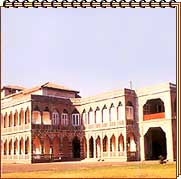 The Saurashtra and Kutch peninsular in the Gujarat had, in days gone by, due to its unique geographical position, provided a safe sanctuary to people fleeing armed invasions and natural calamities. The armed onslaught from west Asia, seeking the riches of the subcontinent, chose either the routes through the Khyber Pass in the northwest or the more difficult passage along the coast of Makran and the Great Thar Desert thus leaving the peninsular relatively peaceful. The Saurashtra and Kutch peninsular in the Gujarat had, in days gone by, due to its unique geographical position, provided a safe sanctuary to people fleeing armed invasions and natural calamities. The armed onslaught from west Asia, seeking the riches of the subcontinent, chose either the routes through the Khyber Pass in the northwest or the more difficult passage along the coast of Makran and the Great Thar Desert thus leaving the peninsular relatively peaceful.
As a consequence the area is home to an amalgam of ethnic groups, among them being the Rajputs who-because of persistent attacks from the Caliphs of Baghdad on Sindhu between the 8th and 11th century-were forced to flee southward with their entourage of courtiers, traders and faithful soldiers.
The movement continued unabated well into the 16th century (1540 AD), till Jam Raval, the Jadeja chief of Kutch and founder of Jamnagar, entered Saurashtra with an army of 4,000 warriors pushing the Jethura rulers against the seaboard of Porbander.
In the 18th century the Gaekwads of Baroda and later the British brought into Saurashtra and Kutch, a measure of stability. The treaty of 1818 imposed by Colonel Walker on behalf of the East India Company, finally helped freeze borders between nearly 200 kingdoms and a political agent administered the region from Rajkot. In the subsequent political quiet of the 19th century, monetary resources-otherwise spent on the battlefield-were used for the construction of beautiful palaces and mansions .
|


